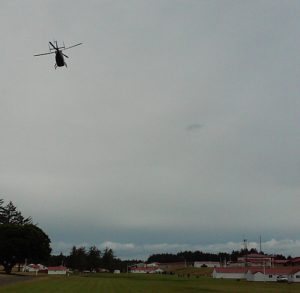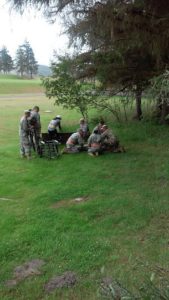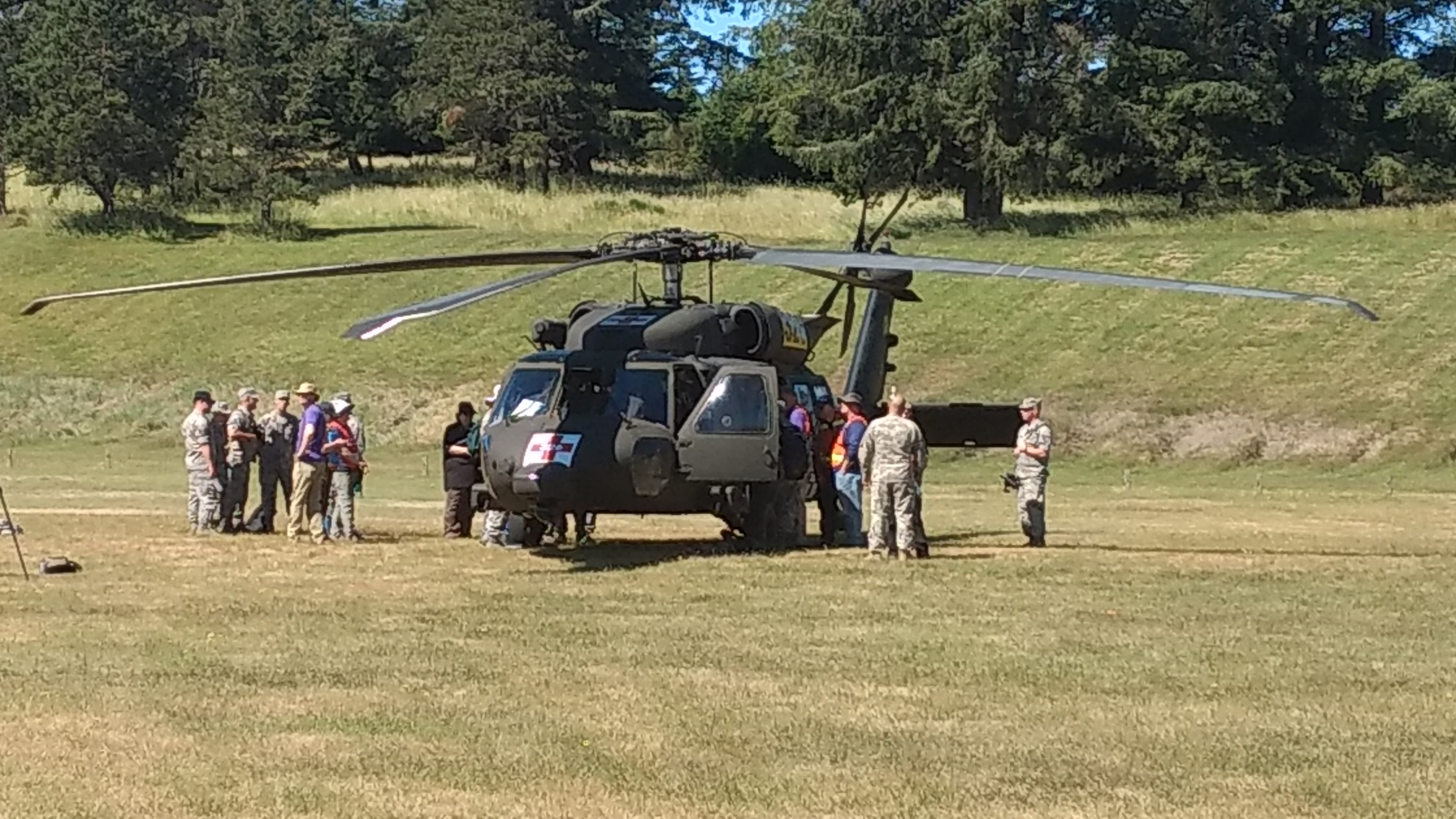One of the biggest challenges facing injured survivors is to receive life-saving care in a medially effective time frame. The majority of the life-saving response will be over within 72 hours.  Key to meeting this need requires extensive pre-planning, dedicated response assets and pre-scripted response procedures at all levels of government. For both events we know where local responders will need significant medical support to meet the life saving mission.
Key to meeting this need requires extensive pre-planning, dedicated response assets and pre-scripted response procedures at all levels of government. For both events we know where local responders will need significant medical support to meet the life saving mission.
One of the challenges for “traditional” response mechanisms will be the damage caused by the events. Survivors will be trapped in isolated communities. On the ground conditions will include:
- No potable water
- No electricity
- Damaged/destroyed infrastructure
- Damaged roads/bridges
- No Ground-based GPS
- No organic communications
 This means that in many cases air assets will be the only viable means of moving critical supplies and personnel in and injured patients out. Both rotary and fixed wing, including float planes have a role. In March of 2011 I made a presentation on the medical consequences of a New Madrid at a ASPR/RHCC meeting in Chicago. At that time I proposed that what was needed to help meet the medical mission were teams were matched to fill the gaps we knew existed. These teams should be:
This means that in many cases air assets will be the only viable means of moving critical supplies and personnel in and injured patients out. Both rotary and fixed wing, including float planes have a role. In March of 2011 I made a presentation on the medical consequences of a New Madrid at a ASPR/RHCC meeting in Chicago. At that time I proposed that what was needed to help meet the medical mission were teams were matched to fill the gaps we knew existed. These teams should be:
- Smaller (general, burn, surgical, pediatric, crush, mental health)
- Self-sustained
- Task Force versus Strike Team (security element critical with your medical team)
- Appropriately trained for the mission
- Appropriately equipt for the mission
- Pre-planned
- Pre-scripted
It was not until I served as the Senior Controller/Evaluator for the Oregon Disaster Medical Team (ODMT) at the Cascadia Rising 2016 exercise that I became aware of an ideal resource for these catastrophic events. The Medical Rapid Response Team (MRRT) is essentially a pilot program of the 173rd Air National Guard (ANG) Medical Group and the Oregon Disaster Response Team. Robert Gentry, MD recently retired as the Oregon ANG State Air Surgeon and Jon Jui, MD, MPH, FACEP are the main reasons this resource currently exists. Jon Jui is the EMS medical director for Portland and Multnomah County, OR. and the deputy team commander for Oregon Disaster Medical Assistance Team.
 The MRRTS can be placed in any area of need and can gather intelligence, provide basic medical care and prepare for a larger follow-on medical package. The MRRTs are designed as an aid for Local Emergency Managers who would make their request to the state. The ODMT in conjunction with the 173rd Medical Group of the ANG have been conducting training and exercises to improve this concept for the past several years.
The MRRTS can be placed in any area of need and can gather intelligence, provide basic medical care and prepare for a larger follow-on medical package. The MRRTs are designed as an aid for Local Emergency Managers who would make their request to the state. The ODMT in conjunction with the 173rd Medical Group of the ANG have been conducting training and exercises to improve this concept for the past several years.
This year additional medical units from both Air National Guard and Army National Guard participated in the Cascadia exercise and were exposed to the MRRT concept. Units flew in from Idaho, Oklahoma, Nevada and Alaska. Just within the ANG are roughly 90 medical groups in all 50 states and across the country who could potentially be equipped, trained and tasked to support this mission. Add in support that could come from Army National Guard units and the potential becomes even more impressive.
Having this type of depth and redundancy is critical since the medical personnel who make up most of these units could potentially be victims themselves if their community or state was impacted. They may also be more valuable serving in their civilian medical capacity. Being able to have this type of quick response force from any non-impacted area fills a critical gap in meeting the medical needs of survivors. For the past three years we have had an average of 86 Presidential disaster declarations. Add in state declarations not rising to a federal level and the number of potential deployments of MRRTs could be fifty to one-hundred times a year. Having assets dedicated to “terrorism” response is great but opportunities for deployment are extremely small for the resources we spend annually.
In my assessment the MRRT is ideally suited to provide medical support at major events and Puerto Rico would have been the ideal testing ground for an actual response. Unfortunately this is an opportunity lost today. Seeing this realized for tomorrow will require additional work, leadership and support at a national level. Without obtaining national level tasking for other ANG or medical assets as MRRTs and minimal financial support for the go-bags this program might not survive much longer.
I’m very interested to hear your thoughts on this potential game changer in supporting local government requests for medical support and how it might have played out this hurricane season.




Aside from the teams you speak of, do the northern Oregon hospital systems have a “Cascadia” plan, individually or as a network–that you know of??
Most of the coastal hospitals include Cascadia in their Hazard Vulnerability Analysis (HVA). I am actually going to be in the area with a two-day course where we spend day one learning and practicing how to use the Hospital Incident Command System and to write Incident Action Plans. Day two will be a table-top exercise where we will use Cascadia as a scenario. This presents a real challenge due to the scope of the event. Ad hoc partnerships will have to be formed from survivors to offer some level of medical care post event. Normally plans are written for individual facilities or networks and/or by counties. In this case it will be a mishmash that bridges them all. Use of the Incident Command System will allow it to work, but the level of cooperative planning necessary pre-event would be non-traditional. Coastal facilities are used to periods of isolation or changes in movement of patients due to weather related events (floods, slides, etc.). A Cascadia changes it from a few days of inconvenience to what realistically could be months.
Jan,
Very good article. FEMA had or has DMAT and DMORT and other types of teams that proved effective in Katrina. Those teams have been gutted and in most cases, from personal knowledge, they aren’t filling the vacancies. What a shame. These folks were professionals in their respective civilian careers and brought personnel already trained to the National Disaster Medical Service (NDMS).
There were/are HHS DMAT and DMORT personnel working at this time but I agree they are undergoing changes. The value of these type of assets go up and down depending on the perception of value based on how many disasters we have, so it’s a tough way to sustain a program. Some of my DMAT colleagues from Oregon who has also participated in the MRRT exercises ended up on a small air-deployed strike teams that very closely followed the MRRT concept in Puerto Rico. She said it cemented in her mind the viability and value of the concept. Will it be the wave of the future…only time will tell.
Jan: So if you have a course scheduled, it suggests that there are employers with people they wish to train to deal with Cascadia-related response issues? Are you talking ambulance crews, Emergency docs or emergency administrators, hospital system administrators or county/city types? I’m interested in how well-coordinated things are at this point, and which agencies or facilities are actively concerned. Then, of course, there is the “survivor” problem you speak of. Portland proper isn’t “coastal,” but it’s got the population and the hazardous infrastructure to deal with.
I’m interested in this for a lot of reasons. I am not aware of anyone in this or any other physician community who thinks about planning for natural disaster. That doesn’t mean they don’t, but it isn’t pressing enough to talk about…….nor is “terrorism medicine” talked about, and I think that’s huge. Karen
For my class coming up there will be hospital clinicians, non-clinicians, some from the c-suite, EMS and MRC personnel in attendance. No public entities are attending as far as I know at this point. My opinion on a Cascadia is that preparedness really has to be at the neighborhood and/or community level based upon how they will be isolated rather than any geo-political boundary. Unfortunately that is not the way planning normally takes place. The coastal counties and states are aware of the challenges that will be facing the coast, but trying to get them support will be difficult at best. Funding streams and significant interest in disaster planning usually follows a disaster rather than proceeds it.